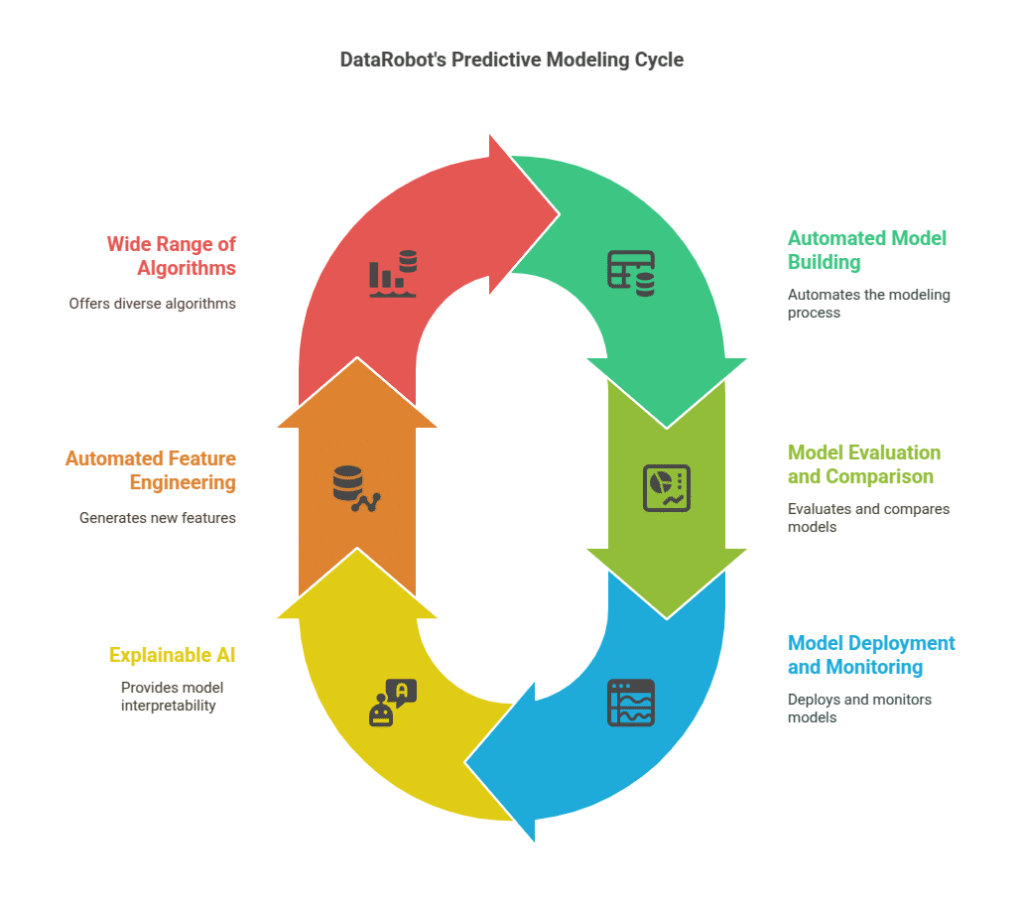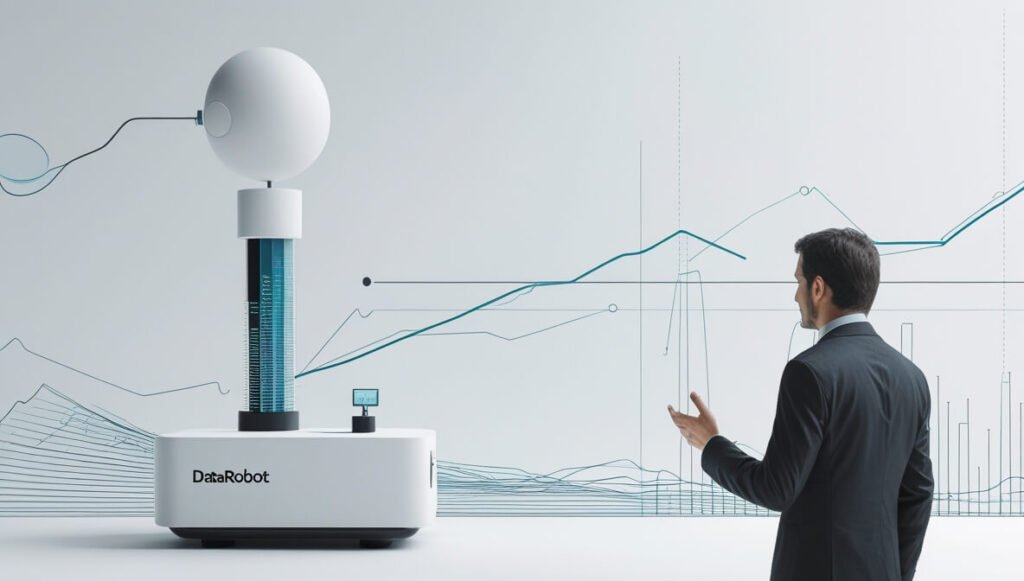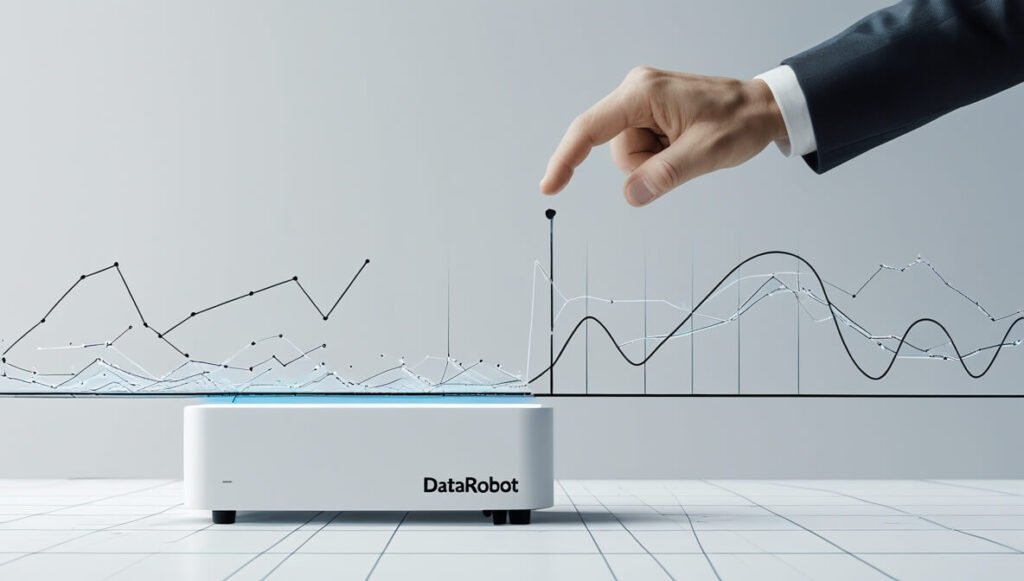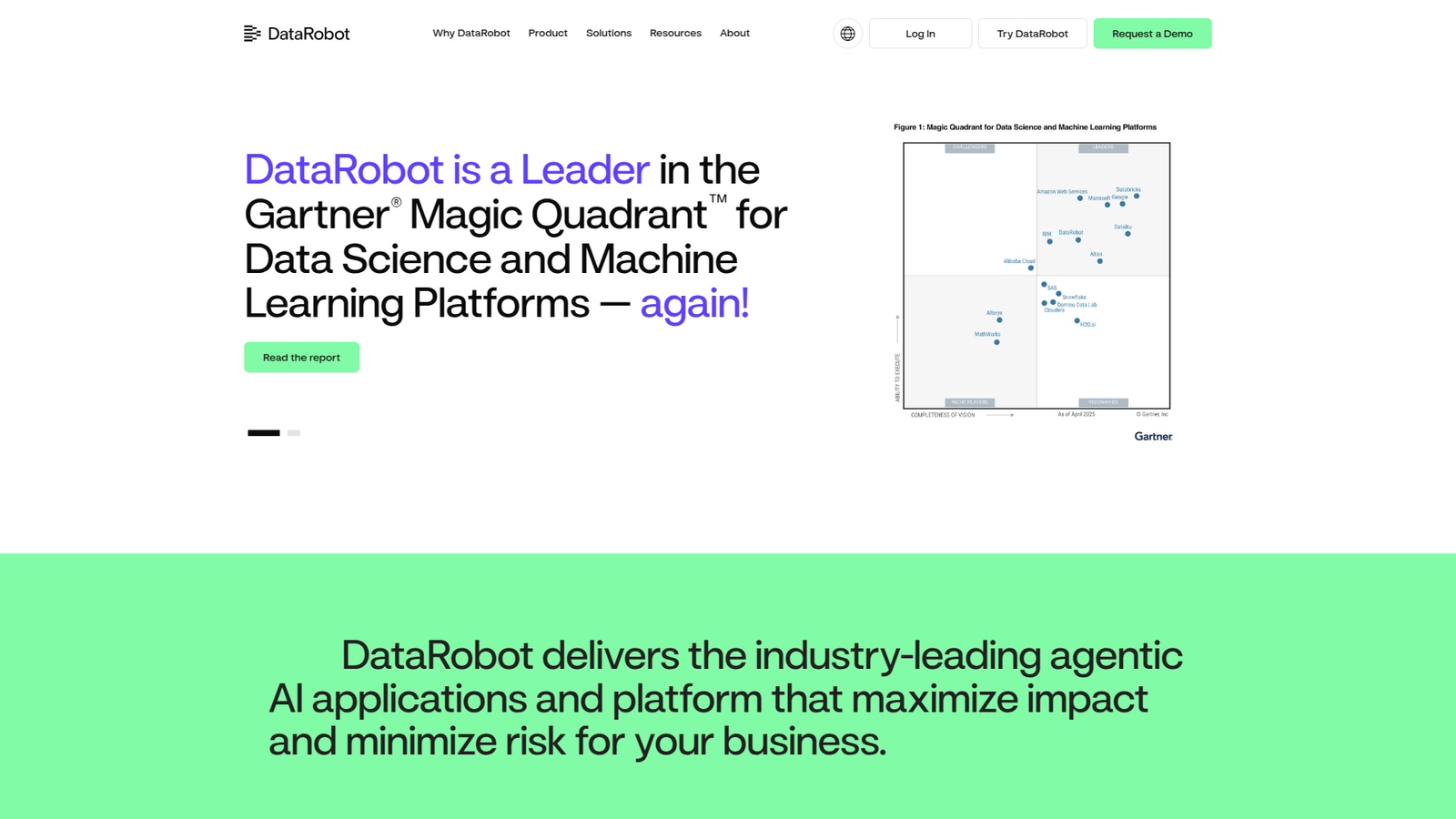DataRobot helps you master Predictive Modeling and Analytics fast. Get better insights, faster decisions, and real business value. Stop guessing, start predicting. Try DataRobot now!
Why DataRobot Is a Game-Changer in Predictive Modeling and Analytics
Let’s be real.
Data. Everyone’s got it. Piles of it.
But turning that data into something useful? Something that tells you what’s likely to happen next?
That’s the gold. That’s Predictive Modeling and Analytics.
And for ages, it felt like scaling Mount Everest.
Complex algorithms. Endless coding. Model after model after model.
Hours turned into days. Days turned into weeks.
Trying to find that one model that actually works. That actually predicts something worth knowing.
Meanwhile, the market moves. Opportunities vanish.
That’s the old way. Slow. Painful. Expensive.
But things are changing. Fast.
AI is everywhere. It’s not just for chatbots anymore.
It’s stepping into the world of Data Analysis and Business Intelligence.
And one tool is making serious noise.
DataRobot.
It promises to make Predictive Modeling and Analytics simple. Fast. Accessible.
Even if you’re not a hardcore data scientist.
Intrigued? You should be.
Because if you’re dealing with data, and you want to predict the future (or at least make a solid guess), you need to know about this.
What is DataRobot?
Okay, let’s cut to it. What exactly is DataRobot?
Think of it as your AI co-pilot for Predictive Modeling and Analytics.
It’s an automated machine learning platform. Sounds fancy, right?
Basically, it does the heavy lifting of building predictive models. Automatically.
You give it your data. Tell it what you want to predict (like customer churn, sales forecasts, risk assessment).
DataRobot gets to work.
It explores your data. Preprocesses it. Figures out the best way to handle missing values or weird formats.
Then, it builds hundreds, sometimes thousands, of different machine learning models. Simultaneously.
It tests them. Scores them. Ranks them based on how well they predict.
And it does this in minutes or hours, not days or weeks.
It’s designed for folks who need predictive power but don’t have an army of data scientists.
Business analysts. Data analysts. Domain experts. Even data scientists looking to speed things up.
Its core mission? Make advanced AI and machine learning accessible and usable for everyone who needs to make better decisions with data.
It’s about getting to insights and predictions faster. A lot faster.
Key Features of DataRobot for Predictive Modeling and Analytics

Alright, let’s talk features. What does this thing actually do to help you with Predictive Modeling and Analytics?
- Automated Model Building:
This is the big one. DataRobot automates the entire modeling process.
You upload your data, select your target variable (what you want to predict), and hit go.
It automatically selects algorithms, performs feature engineering, tunes hyperparameters, and builds a leaderboard of models.
This saves a ridiculous amount of time and effort compared to manual coding.
It means you can build and test many more models than a human ever could in the same timeframe.
This speed lets you iterate faster and find the best possible model for your problem.
It’s like having a whole data science team working for you 24/7, without the coffee breaks.
- Model Evaluation and Comparison:
Building models is one thing. Knowing which one is best is another.
DataRobot provides extensive tools to evaluate and compare models.
It gives you standard metrics like AUC, RMSE, accuracy, precision, recall, and many more, depending on the problem type.
But it goes deeper. It provides visualisations like lift charts, ROC curves, and confusion matrices.
Crucially, it offers insights into model fairness and potential bias.
You can easily see how different models perform against each other on various metrics and different data subsets.
This transparency helps you pick not just an accurate model, but the *right* model for your specific business need and constraints.
No more guessing games about which model is the true champion.
- Model Deployment and Monitoring:
A predictive model is useless if you can’t actually use it to make predictions on new data.
DataRobot simplifies deployment. You can deploy models with a few clicks.
It provides APIs so you can integrate the model into your existing systems – websites, apps, databases, whatever you need.
But deployment is just the start. Models degrade over time as the real world changes.
DataRobot offers robust model monitoring.
You can track model performance in real-time, monitor data drift (when your new data looks different from the data used to train the model), and track prediction drift.
This lets you know when a model is starting to fail and needs retraining or replacement.
It ensures your predictions stay relevant and accurate over time, protecting your business decisions.
This end-to-end capability, from data to deployment and monitoring, is a massive advantage.
- Explainable AI (XAI):
This is huge, especially in business.
It’s not enough to just get a prediction. You often need to know *why* the model made that prediction.
DataRobot provides tools for model interpretability.
You get feature importance scores, showing which variables had the biggest impact on the predictions.
It offers tools like Prediction Explanations, which tell you why a *specific* prediction was made for an individual data point.
This is invaluable for trust and adoption.
Compliance with regulations often requires being able to explain automated decisions.
Business users are more likely to trust and use a model they understand, even at a high level.
XAI makes your predictive models auditable and actionable, not just black boxes.
- Automated Feature Engineering:
Crafting the right features from raw data is one of the most time-consuming parts of building models.
DataRobot automates this too.
It explores relationships in your data and automatically generates new, potentially more powerful features.
Things like combining features, creating polynomial terms, or handling date/time data properly.
This can significantly improve model performance without requiring deep domain expertise or manual trial-and-error.
It finds signals in your data you might have missed otherwise.
More relevant features mean better models, faster.
- Wide Range of Algorithms:
DataRobot doesn’t just pick one type of model.
It includes a massive library of machine learning algorithms from various families.
Regression, classification, time series, clustering – you name it.
This diversity means it can automatically try many different approaches to find the one that best fits your specific data and problem type.
You don’t need to know which algorithm is best beforehand.
DataRobot figures it out through experimentation.
This exhaustive search increases the chances of finding a highly accurate and robust model.
Benefits of Using DataRobot for Data Analysis and Business Intelligence
Okay, so it has cool features. But what’s the payoff? How does it actually help Data Analysis and Business Intelligence professionals?
Let’s break it down.
Speed: This is probably the biggest win.
What used to take weeks or months of manual work – cleaning data, trying models, tuning them – DataRobot does in hours.
This insane speed means you can go from raw data to a working predictive model incredibly quickly.
You can test more ideas. Explore more possibilities. Get insights while they are still actionable.
Decisions can be made based on predictions now, not three months from now.
Accessibility: You don’t need a PhD in machine learning to use DataRobot.
Business analysts, domain experts, even savvy business users can build powerful predictive models.
The platform guides you through the process. It automates the complex stuff.
This democratizes access to advanced analytics.
Teams can build their own models without relying on a scarce data science resource.
This puts predictive power directly into the hands of the people closest to the business problems.
Accuracy: Because DataRobot automatically builds and tests so many different models and does extensive feature engineering, it often finds more accurate models than a human could manually build in the same time.
Its rigorous cross-validation and evaluation methods help prevent overfitting.
This leads to more reliable predictions.
More accurate predictions mean better business outcomes – whether it’s reducing churn, increasing sales, or mitigating risk.
Cost Reduction: Less manual work means less time spent by expensive resources.
You can achieve more with your existing team.
Or, enable less technical staff to perform advanced analytics tasks.
Also, getting to market or making critical decisions faster based on predictions can save significant money or unlock new revenue streams.
Scalability: DataRobot is built for the enterprise.
It can handle large datasets. It can deploy and manage many models simultaneously.
As your needs grow, DataRobot scales with you.
You’re not limited by the capacity of individual analysts or manual processes.
It allows predictive analytics to move from a niche function to a core capability across the organisation.
Reduced Risk: The automated evaluation and monitoring features help reduce the risk of deploying flawed or degrading models.
Explainable AI helps ensure models are fair and compliant.
This leads to more trustworthy and responsible use of AI in decision-making.
No one wants to base critical business decisions on a shaky model. DataRobot adds layers of confidence.
Pricing & Plans

Alright, the money talk. What does DataRobot cost?
Like many enterprise-level AI platforms, DataRobot doesn’t publish simple, fixed pricing on their website.
Why? Because their pricing is typically customized based on the size of your organization, your specific needs, the scale of data you’ll process, and the modules or features you require (like automated machine learning, MLOps, AI apps, etc.).
There isn’t a “free plan” in the way you might see for a simple online tool.
However, they do offer demos and proof-of-concept engagements.
This allows prospective customers to test the platform with their own data and see the value before committing.
Premium features typically include access to the full automated machine learning suite, advanced tuning options, comprehensive model monitoring, MLOps capabilities for deploying and managing models at scale, governance features, and dedicated support.
Compared to alternatives, DataRobot is positioned as a leader in the enterprise automated machine learning space.
Alternatives might include platforms from major cloud providers (AWS SageMaker Autopilot, Google Cloud AutoML, Azure Automated ML) or other specialized AutoML vendors.
DataRobot often distinguishes itself with its breadth of automation, depth of model evaluation tools, and enterprise-grade MLOps capabilities.
Its focus is heavily on usability for a wider range of users beyond just data scientists.
While the exact cost requires a conversation with their sales team, the value proposition is based on significant time savings, increased model accuracy, and enabling a broader set of users to build and deploy predictive models quickly.
Think of it as an investment in accelerating your predictive analytics capabilities.
The ROI often comes from faster insights, better decisions, and the ability to operationalize machine learning predictions across the business effectively.
Hands-On Experience / Use Cases
Okay, let’s talk about what it feels like to *use* DataRobot for Predictive Modeling and Analytics.
Imagine this: You have a dataset of past customer behaviour. You want to predict which customers are likely to stop using your service next month (churn).
Without DataRobot, you’d spend hours cleaning this data. Handling missing values. Converting categories into numbers.
Then, you’d pick a model type – maybe logistic regression, maybe a tree-based model like Gradient Boosting.
You’d write code to train the model. Evaluate it. Tweak parameters. Train again.
Maybe try a different algorithm. More coding. More evaluation.
It’s a cycle of code, train, evaluate, repeat. It takes time. It requires expertise.
Now, DataRobot.
You upload your customer data.
You tell it the ‘target’ is the column indicating whether a customer churned or not.
You press “Start”.
DataRobot automatically detects the data types. It figures out how to handle missing data. It engineers potentially useful features.
Then, it starts building models. You see a “Leaderboard” filling up in real-time.
Hundreds of models, built using different algorithms and approaches, appear on the list, ranked by their accuracy score (e.g., AUC for a churn prediction problem).
You can click on any model to see detailed evaluation metrics, visualizations, and understand *why* it performed the way it did.
You can explore feature importance – seeing which factors (like usage frequency, time with service, customer support interactions) are most predictive of churn.
You pick the best model from the Leaderboard based on your specific needs (not just accuracy, but maybe interpretability or speed).
Deploying it? Often just a few clicks. You get an API endpoint ready to integrate into your CRM or marketing system.
This isn’t a simulation; this is how it works. The usability is high, even for complex tasks.
Results? Faster time to insight. You get a working, evaluated model in hours, not weeks.
More accurate models because DataRobot explored more options than you likely could manually.
Actionable insights thanks to the explainability features. You don’t just know *who* might churn, but *why*.
Other common use cases:
Predicting sales demand.
Identifying fraudulent transactions.
Forecasting equipment failures.
Optimising marketing campaigns by predicting response rates.
Assessing credit risk.
Pricing products dynamically.
DataRobot handles these problems and many more with the same core workflow: data in, automated modeling, evaluated leaderboard, easy deployment.
It takes the technical heavy lifting out, letting users focus on the business problem and interpreting the results.
Who Should Use DataRobot?

So, who exactly is this platform for? Who gets the most juice out of DataRobot for Data Analysis and Business Intelligence?
First off, Business Analysts.
These are the folks who understand the business problems and the data, but might not be expert coders or machine learning specialists.
DataRobot empowers them to build predictive models directly, without waiting in line for a data scientist.
They can quickly test hypotheses and get data-driven answers.
Next, Data Analysts.
They are comfortable with data, SQL, visualization tools. They might do some scripting but aren’t necessarily deep into machine learning algorithms.
DataRobot helps them move beyond descriptive analytics (“what happened?”) to Predictive Modeling and Analytics (“what will happen?”).
It significantly accelerates their workflow for building models compared to manual methods.
Data Scientists also benefit.
Wait, I thought DataRobot was for non-experts?
Yes, but it also makes data scientists more productive.
It automates the tedious parts – data prep, trying standard models, hyperparameter tuning.
This frees up data scientists to work on more complex problems, research novel algorithms, or spend more time on interpreting results and collaborating with the business.
They can use DataRobot to quickly baseline performance or generate features, then dive into custom coding if needed.
Organisations of various sizes benefit.
For small to medium-sized businesses, DataRobot can provide access to sophisticated predictive analytics without needing a large, dedicated data science team. It’s like having a scaled-down version of an enterprise capability.
For large enterprises, DataRobot provides consistency, governance, and scalability across different departments and use cases. It helps spread the use of AI beyond R&D teams to functional areas like marketing, sales, operations, and finance.
Basically, anyone who needs to make better, data-driven decisions based on future probabilities, and wants to do it quickly, accurately, and without needing a black belt in coding, should look at DataRobot.
If you have data and a question about the future, DataRobot is designed to help you get an answer.
How to Make Money Using DataRobot
Okay, let’s talk brass tacks. Can you actually turn DataRobot into cash flow?
Absolutely. It’s a tool that generates significant business value, and value can be monetized.
Here are a few ways:
- Offer Predictive Analytics as a Service:
If you’re an agency, consultant, or freelancer in the Data Analysis and Business Intelligence space, DataRobot is a superpower.
You can offer predictive modeling services to clients who lack the internal expertise or tools.
Think lead scoring for sales teams, customer churn prediction for subscription businesses, inventory demand forecasting for retailers.
DataRobot lets you deliver accurate models quickly and cost-effectively, which you can then charge a premium for.
Your speed and capability become your competitive advantage.
- Improve Efficiency and Outcomes for Existing Clients:
Already work with clients on data projects? Integrate Predictive Modeling and Analytics using DataRobot.
Instead of just reporting on past sales, predict future sales.
Instead of just segmenting customers, predict which segment is most likely to buy a new product.
These enhanced services increase the value you provide, justifying higher fees or retaining clients longer.
The efficiency gains from DataRobot mean you can take on more projects or deliver results faster for the same price, increasing your margin.
- Build and Sell Predictive Applications:
DataRobot allows you to deploy models via APIs or even build simple AI Apps directly within the platform.
You could identify a common business problem in a niche (e.g., predicting equipment failure in manufacturing).
Build a robust predictive model using DataRobot based on relevant data.
Then, wrap that model in a simple interface or integrate it into a dashboard.
You could sell subscriptions to this predictive application or the underlying API access.
DataRobot provides the engine, you build the product around it.
Consider someone like Sarah, a marketing consultant for e-commerce businesses. Before DataRobot, she might help clients analyze past campaign performance. Now, using DataRobot, she can take their customer data and build a model that predicts which customers are most likely to respond to the *next* campaign. She charges clients a higher monthly retainer for this predictive service. Her clients see a direct lift in campaign ROI, making it a no-brainer investment for them, and DataRobot makes it feasible for her to deliver this advanced capability without being a data science guru. That’s direct monetization of the tool’s capability.
Another example: a small consultancy helping non-profits with fundraising. They use DataRobot to predict which past donors are most likely to donate again or increase their donation size. They offer this as an add-on service. By increasing fundraising efficiency for the non-profit, they deliver tangible value and justify their fee.
DataRobot isn’t just a cost center; it’s a capability builder. By enabling faster, more accurate, and more accessible predictive analytics, it creates opportunities to offer new services, improve existing ones, and ultimately drive revenue for yourself or your business.
Limitations and Considerations
Look, no tool is perfect. DataRobot is powerful, but it has limits and things you need to consider.
Data Quality In, Data Quality Out: This is the golden rule of data science. DataRobot can automate the *process* of building models, but it can’t magically fix bad data. If your input data is inaccurate, biased, or incomplete, the models built on it will be too. You still need to invest time in understanding and cleaning your source data *before* you feed it into DataRobot. It amplifies the quality of your data, good or bad.
Not a Replacement for Deep Domain Expertise: DataRobot can build a model predicting customer churn, but it won’t tell you *why* customers are churning from a business perspective. You still need someone who understands the business context to interpret the model’s findings, identify the root causes, and design the actual business actions to address the problem. The AI gives you the *what*, humans provide the *why* and *how to fix it*.
Learning Curve for Full Potential: While DataRobot is designed to be accessible, mastering all its features – especially model deployment, monitoring, and advanced evaluation metrics – takes time. It’s not just a ‘push button, get answer’ tool if you want to get the most out of it and trust your results in production. Understanding model evaluation metrics, potential biases, and how to interpret the Explainable AI features requires some level of analytical literacy.
Cost: As discussed, DataRobot is an enterprise-grade platform. It’s an investment. It’s likely priced higher than simple open-source tools or basic cloud AI services. You need to ensure the business value you gain justifies the cost. It’s not a cheap tool for occasional use.
Explainability Can Still Be Complex: While DataRobot provides Explainable AI features, interpreting those explanations correctly still requires understanding the underlying concepts. Explanations might show correlation, but causation still needs domain knowledge to confirm.
Not for Every Problem: DataRobot excels at structured data problems like regression, classification, and time series. It’s not designed for tasks like natural language processing (understanding text sentiment), computer vision (analyzing images), or reinforcement learning out-of-the-box in the same automated way. Know the tool’s strengths and limitations.
So, while DataRobot removes a lot of the complexity and manual effort from Predictive Modeling and Analytics, it doesn’t remove the need for critical thinking, domain knowledge, and a good understanding of your data. It’s a powerful engine, but you still need a skilled driver and navigator.
Final Thoughts
Let’s wrap this up. DataRobot? It’s the real deal for Predictive Modeling and Analytics, especially within Data Analysis and Business Intelligence.
If you’re tired of manual processes, waiting ages for models, or feeling like predictive analytics is only for elite data scientists, DataRobot is built for you.
It takes the complexity out, speeds everything up, and puts powerful AI capabilities into the hands of people who can actually use the predictions to make better business decisions.
Is it cheap? No. Is it perfect? No tool is. You still need good data and smart people to interpret results.
But the value it unlocks is significant. Faster time to insight, more accurate models, wider adoption of AI across the organisation, and the ability to operationalize predictions at scale.
For businesses looking to move beyond just reporting on the past and start predicting the future, DataRobot is a serious contender.
It’s not just automation; it’s acceleration and democratization of predictive power.
My recommendation? If you have data and a need for predictions, and the manual way is slowing you down, investigate DataRobot.
See if the efficiency gains and enhanced capabilities justify the investment for your specific use cases.
It could fundamentally change how your organisation approaches data and decision-making.
It’s not just another tool; for many, it’s a catalyst for becoming truly data-driven and predictive.
Visit the official DataRobot website
Frequently Asked Questions
1. What is DataRobot used for?
DataRobot is primarily used for automated machine learning, specifically for building and deploying predictive models. It helps users quickly create models for tasks like predicting customer churn, forecasting sales, identifying fraud, and assessing risk based on their data.
2. Is DataRobot free?
No, DataRobot is an enterprise-level platform and does not offer a free plan. Pricing is customized based on organizational needs and usage, typically requiring a discussion with their sales team.
3. How does DataRobot compare to other AI tools?
DataRobot is a leader in automated machine learning platforms. It competes with cloud provider AutoML services and other MLOps platforms. Its strengths include broad automation, detailed model evaluation, and robust MLOps capabilities designed for enterprise scale and usability.
4. Can beginners use DataRobot?
Yes, DataRobot is designed to be accessible to users beyond data scientists, including business analysts and data analysts. While understanding analytical concepts helps, the platform automates much of the technical complexity of building models.
5. Does the content created by DataRobot meet quality and optimization standards?
DataRobot doesn’t create text content. It builds predictive models based on numerical and categorical data. The quality and ‘optimization’ of the output depend on the quality of the input data and the suitability of the model for the specific predictive task.
6. Can I make money with DataRobot?
Yes, absolutely. You can use DataRobot to offer predictive analytics services to clients, improve the efficiency and value of your existing consulting or agency work, or even build and sell predictive applications powered by DataRobot’s models.






